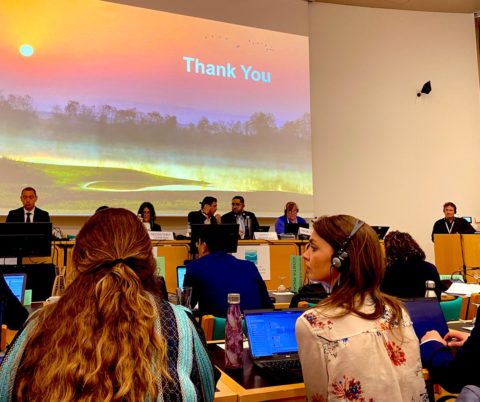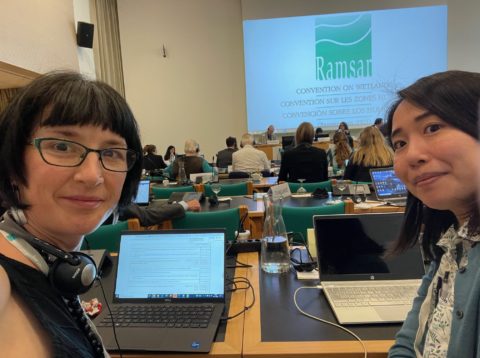
Downstream from Davos, wetlands meeting focused on climate, biodiversity and youth
Whilst the World Economic Forum meeting in Davos dominated the news last week, government representatives from all over the world gathered elsewhere in Switzerland for a key meeting of the Ramsar Convention on Wetlands. This is the world’s oldest environmental treaty, founded in the Iranian city of Ramsar in 1971 and celebrated its 50th anniversary last year. At present 172 countries have signed the Convention.
Biodiversity, climate change, food, and water security were top of the agenda at this Ramsar Standing Committee meeting, which included preparations for the 14th Conference of Parties COP14, scheduled for November in Wuhan, China. This falls immediately after the COP27 UN Climate Summit hosted by Egypt, where water is expected to be a hot topic. The Ramsar COP also follows shortly after the UN Biodiversity Conference COP15, also hosted by China, and where the role of wetlands in the global recovery of biodiversity needs far greater recognition.

One key message from the Ramsar standing committee was that wetlands are critical to achieving global goals on biodiversity, climate, and sustainable development. Government representatives and other participants considered dozens of draft resolutions and reports. Twenty five new Wetland City accreditations were confirmed. Some highlights were as follows:
Wetlands as nature-based solutions to climate change
A draft resolution submitted by Spain highlighted wetland protection, management, and restoration as Nature-based solutions to address the climate crisis. This focused on coastal wetlands in the Mediterranean region as ‘blue carbon’ and the acute pressure that climate change is putting on wetland ecosystems in the region.
Many countries called for a more global remit, recognizing that wetlands, including peatlands, are powerful nature-based solutions all around the world. The draft resolution urges closer links with other international conventions to promote wetlands as nature-based solutions for climate mitigation and adaptation, a study of success stories on wetlands as nature-based solutions, and a new technical handbook to help scale-up action.
Integrating wetlands into national sustainable development strategies
China proposed a draft resolution on integrating wetland conservation and restoration into national sustainable development strategies, which also referenced wetlands as nature-based solutions and was broadly welcomed. China explained that wetlands are still often treated in isolation, whereas they should be a key element in delivery of the 2030 sustainable development goals at the local and national levels.
The draft text highlights the contribution of wetlands to poverty eradication and disaster reduction as well as their climate and biodiversity value. It encourages countries to set targets for the management and restoration of wetlands and calls for closer cooperation with the UN Commission on Sustainable Development alongside tools, guidance, and case studies to support action at the local and national levels.
Post-2020 global biodiversity framework
With the global summit to agree on the post-2020 biodiversity framework fast approaching, a theme running through several draft resolutions and reports was the need for even closer connections between the Convention on Wetlands and the Convention on Biological Diversity. Wetland ecosystems host remarkable biodiversity: 40% of all species live or breed in wetlands.
The recent addition of freshwater habitats alongside land and oceans in the post-2020 biodiversity framework text was a fantastic step forward. International Organization Partners highlighted that incorporating wetlands-specific language, targets, and indicators into the new global biodiversity framework would help deliver a nature-positive world.
Youth and wetlands
The youth stepped into the spotlight when Australia and Costa Rica proposed a draft resolution to strengthen youth inclusion in the Ramsar Convention and to make youth and wetlands a key theme for the Ramsar COP in November. Members of Youth Engaged in Wetlands (YEW) contributed to the debate and got by far the biggest cheers of the week. Youth Engaged in Wetlands is the leading youth network for wetlands. It empowers and enables young people to protect and promote wetlands through raising awareness, building capacity, fostering partnerships, campaigning for action, and exchanging information.
In line with the principle of ‘intergenerational responsibility’ set for this week’s Stockholm+50 UN meeting, the draft resolution calls on Governments to engage, mentor, and support current and future generations of young wetland scientists, policymakers, managers, educators, and communicators via a range of actions.
What next?
The Ramsar COP in November will have the theme “Wetlands action for people and nature”. Countries will debate, amend and adopt final resolutions that will steer action over the coming three years. Four new Ramsar award winners will be announced.
In the meantime, the Ramsar family of governments, scientists, local communities, NGOs, international organizations and others will work hard to ensure the power of wetlands in tackling multiple environmental crises is fully embraced. We’ll accelerate the implementation of ambitious and practical wetland conservation and restoration work all around the world. And we’ll continue to make the most of the expertise and insight of Ramsar bodies such as the Scientific and Technical Review Panel (STRP). Recent STRP activity has prioritised sustainable agriculture, peatland rewetting/restoration, and blue carbon. Publications include a wealth of topical policy briefs, technical reports, and briefing notes, and of course the Global Wetland Outlook: Special Edition 2021.

In this UN Decade on Ecosystem Restoration, championing, and scaling up wetland conservation and restoration is more important than ever. The designation of 22 new Ramsar sites over the past year is cause for celebration. With wetlands facing major threats from climate change, human-built infrastructure, and land-use change, the need for all existing Ramsar sites to be properly protected and managed for the benefit of nature and people must be an equally high priority. The Ramsar Convention has a unique and leading role to play. Its next Strategic Plan will be crucial – providing the ambition, clarity, and leadership required for global wetland recovery.
***
The Ramsar Convention on Wetlands gives special recognition to six international NGOs, which have a formal relationship as International Organization Partners (IOPs). These are Birdlife International, the International Water Management Institute, IUCN, Wetlands International, Wildfowl & Wetlands Trust, and WWF. IOPs work actively at local, national, regional, and global levels, as well as with the Ramsar Secretariat and Scientific and Technical Review Panel, to help achieve the goals of the convention on the conservation and wise use of wetlands.
